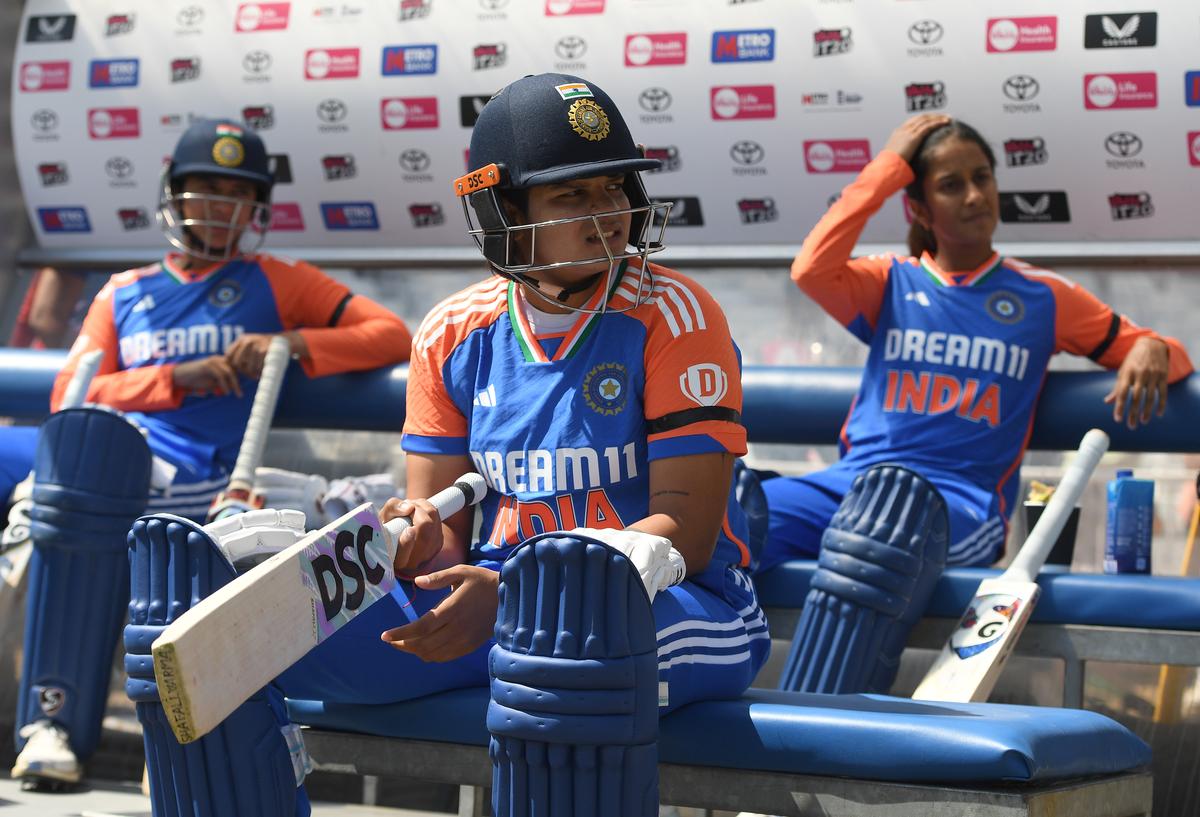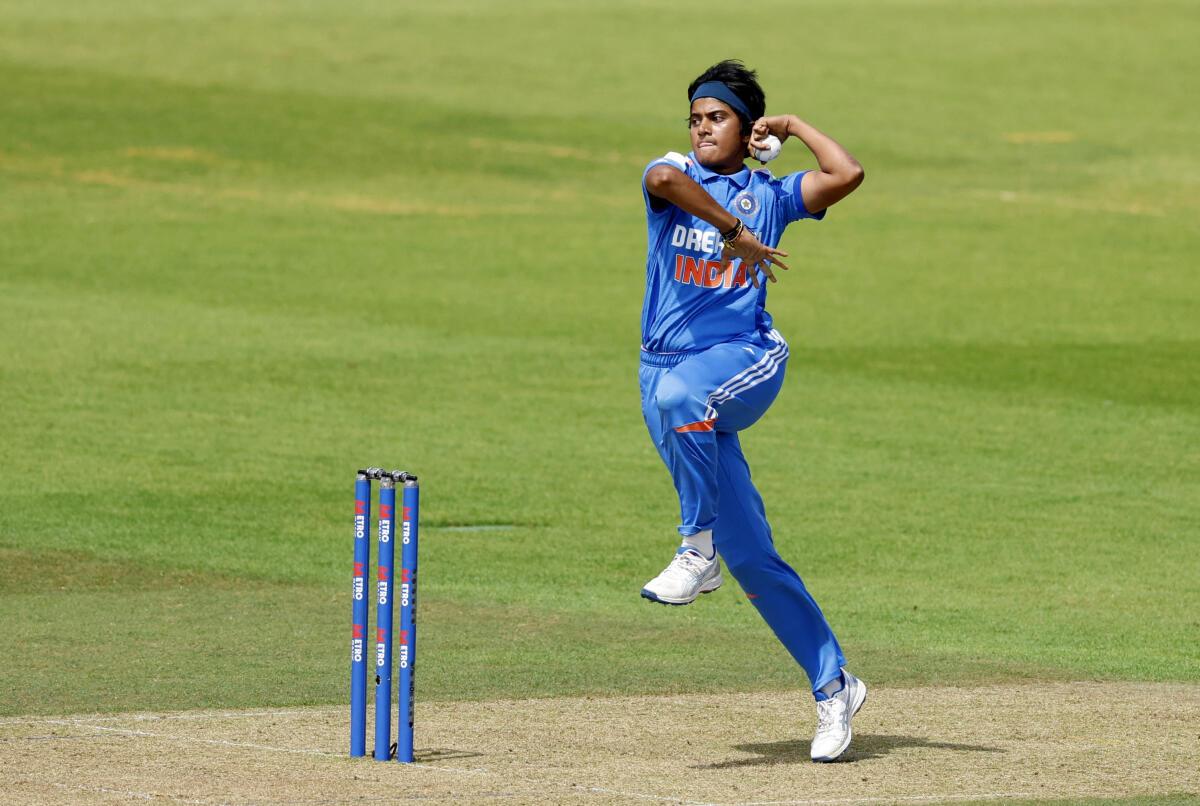
For years, India has been trying to perfect the formula to be one of the world’s best cricketing sides. From one ODI World Cup cycle to the next, a new deficiency would emerge for the outfit to tackle.
For the longest time, India’s fielding was its Achilles heel. A brittle tail would often derail the side’s surge against tough opponents. Its pace reserves were seen as lean, its middle order unsettled.
Against this backdrop, India’s recent outing in England – which saw victories for the visitor in the five-match T20I series and three-match ODI series – proved to be a much-needed demulcent. India batted with intent, got plenty of validation for its work in grooming a larger bowling pool, and finally clicked as an imposing unit on the field.
That said, this side is just getting started – it would do well to remember.
ALSO READ | Deepti Sharma’s sweep shot behind her batting renaissance
Track record
The 50-over World Cup gets underway in India, with a spillover in Sri Lanka to accommodate Pakistan, in two months. After a dismal group-stage exit in the T20 showpiece in the UAE, the push to get things right for the One-Day version understandably intensified. On the face of it, India responded well with 14 wins in 20 ODIs.
But the matter of interest is those six losses.
A stuttering New Zealand put on quite the all-round show in the 2nd of three ODIs in November 2024, with Sophie Devine leading the way with a half-century and three wickets. The Kiwis may have tamely surrendered the series to India in the next fixture, but that loss left India with an itch. Old ailments returned to haunt the side: a limp top order, poor fielding, and a bowling attack that crumbled under pressure.
India then headed to Australia, only to have its vulnerabilities laid bare. A merciless 0-3 hammering followed, including a performance that saw India bowled out for just 100 (in the first ODI). India’s batting – barring a century from Smriti Mandhana and a fifty from Richa Ghosh in different games – largely failed.
A merciless 0-3 hammering followed, including a performance that saw India bowled out for just 100 (in the first ODI).
| Photo Credit:
Getty Images
A merciless 0-3 hammering followed, including a performance that saw India bowled out for just 100 (in the first ODI).
| Photo Credit:
Getty Images
While Saima Thakor and Arundhati Reddy – who stunned all with a career-best spell (4/26 in the 3rd ODI) – showed promise, it wasn’t enough to stop a wounded Australian machine, fresh from the heartbreak of a T20 World Cup semifinal exit.
As unfashionable as it is to state, India’s runs against West Indies – lone wolf Hayley Matthews’ valiant resistance notwithstanding – and Ireland were expected to be comfortable. The Women in Blue utilised those two series to embark on a milestone-collecting spree, achieving record totals and massive wins.
They also laid the foundation for a promising new top-order pairing of Smriti and Pratika Rawal. Harleen Deol, with a century under her belt, made a case to claim the No.3 spot. Sneh Rana made a comeback to the ODI setup after 485 days and marked her return with a match-winning fifer against South Africa. Scribbled in the corner of every series review, though, was the question about a restless Shafali Verma warming the bench after being shunted out of the ODI setup for inconsistency since India’s tour of Australia.
Sri Lanka challenged India in the Tri-Series, handing it its only loss of the tournament in the league stage. Its bowlers hunted in packs as they restricted a determined India to 275/9. Once more, when batters took on the attack and struck at a fast pace, India – quite quickly – ran out of ideas.
ALSO READ | Shafali Verma’s comeback: How watching videos of Tendulkar helped the India opener stay motivated

The sixth loss came in a rain-curtailed, 29-overs-a-side game at Lord’s against England.
| Photo Credit:
GETTY IMAGES
The sixth loss came in a rain-curtailed, 29-overs-a-side game at Lord’s against England.
| Photo Credit:
GETTY IMAGES
The sixth loss came in a rain-curtailed, 29-overs-a-side game at Lord’s against an England lineup missing Heather Knight. India’s bowlers – who had dominated the English through most of the five-match T20Is and in the first ODI – could only watch as the top order made quick work of a 144-run target. This came after Sophie Ecclestone rediscovered her mojo and galvanised England’s spin clique.
Here too, India eventually won the series, and quite decisively. But the slips and trembles along the way are not easy to dismiss.
Last-minute tweaks
A major issue for India was inconsistency at the top. The Shafali-Smriti combo was lethal when it clicked, but those days weren’t nearly as frequent as India would have liked. This pair has given India 893 runs at an underwhelming average of 37.20 in 25 innings. Meanwhile, Pratika and Smriti have opened the innings just 14 times (all in 2025) and have scored 1086 runs at double the average – 77.57.
With Shafali, Smriti managed only two 100-plus stands, while with Pratika she produced four, including a massive 233-run partnership that helped India beat Ireland by 304 runs to seal its biggest win in the format.

Will India gamble with Shafali Verma — who has not featured in an ODI since 2024 — for the World Cup?
| Photo Credit:
Getty Images
Will India gamble with Shafali Verma — who has not featured in an ODI since 2024 — for the World Cup?
| Photo Credit:
Getty Images
That doesn’t mean Shafali’s tryst in the opening slot is a thing of the past. Her briskness, aggressive strokeplay, and blatant disregard for reputation are inimitable. Pratika is a classical player, striking at 87.43. Shafali’s numbers aren’t any better, but she has an extra gear that we’ve yet to see from Pratika.
Head coach Amol Muzumdar has virtually thrown the gauntlet by stating that Shafali will “definitely be in the mix” for India. Will the side choose proven stability over the possibility of flair?
One way to honour both may be to use Pratika at No.3, which loosens the mud under Harleen’s feet. But that combination hasn’t been tried out so far, and only one series – at home against Australia – remains before the World Cup to even consider experimenting.
Since South Africa toured India in 2024, Smriti’s ODI trajectory has also shifted. In the 23 ODIs since, she has six hundreds and five fifties to her name. More significantly, she has frequently maintained a strike rate of above 100 – not typical of her style in the format. Her command early in the innings has helped India set up some of the big scores it has posted in this period.
Skipper Harmanpreet’s fluctuating fortunes with the bat have been inconvenient in the past and continue to be so today – especially when those around her have been armtwisted to tweak their game.
The No.4 slot comes with crucial anchoring duties at a fairly brisk pace. The average run rate in women’s ODIs has also, for the first time in history, crossed five runs per over this year. The average first-innings total is 255.6, and the average winning total is 281.6. Harmanpreet herself, ahead of the England ODIs, stated that India wants to make 300-plus scores a habit. The side will be better placed to do so if she can settle early and unleash her naturally explosive style of scoring.
Marks of success
While India has more or less decided on its top six or seven batters, the bowling department continues to pose headaches – not all of them the good kind.
The side’s most prolific quick, Renuka Singh Thakur, has missed a chunk of the season due to injury. Pooja Vastrakar has been out of action for even longer. Shreyanka Patil remains under medical observation at the BCCI’s Centre for Excellence.
But in their absence, a crop of feisty youngsters has fearlessly gone about staking a claim for a World Cup spot. Pacer Kranti Goud and left-arm spinner Shree Charani were two big positives from India’s tour of the British Isles. Charani took home the Player of the Series award in the T20I leg, while Kranti’s six-wicket haul helped India rout England and seal the ODI series 2-1 in Durham.

Shree Charani took home the Player of the Series award in the T20I leg.
| Photo Credit:
REUTERS
Shree Charani took home the Player of the Series award in the T20I leg.
| Photo Credit:
REUTERS
Both fast learners and unfazed by the occasion or the veterans they face, Kranti and Charani will be closely watched during Australia’s visit in a few weeks. Sneh wasn’t rolling in wickets, but her unplayable overs, stingy economy rate, and handy batting make her an obvious pick. Amanjot Kaur has also impressed, taking on new-ball duties while providing quick runs when needed.
India has always fielded an impressive array of spinners. Deepti Sharma has emerged as a cut above the rest, finding a way to evolve and reinvent even as tweakers come and go around her. But that ever-changing pool has seen some solid talent.
Against England, Indian spinners took 25 of the 40 English wickets to fall in the T20I leg. Their English counterparts could only manage nine of the 23 Indian scalps claimed. The Sophie Ecclestone-led attack bounced back in the ODIs, evening the scales and finding form. But India had the momentum, and an England side in transition – with a new leadership group – was no match.
“What we have started here….going forward, the Indian women’s cricket team should be known as the best fielding side in the world.”JEMIMAH RODRIGUESafter India’s 2-1 win over England in ODIs
But perhaps the biggest shot in the arm for this team has been its elevated quality in the field. A younger core of players now features athletes who aren’t afraid to put their bodies on the line. There was a time when acrobatic brilliance from Harleen or Radha Yadav was the only means to feel hopeful about India’s ability as a fielding unit. Holding on to tough catches and deploying direct hits have become the norm – a result of years of hard work and dedicated camps, like the one at the National Centre of Excellence before the side’s British sojourn, paying rich dividends.
Muzumdar, when he took over, spoke of wanting his batters to pitch in with the ball. As part of that experiment, we got to see Smriti’s own half pace-half spin action. Realistically though, Pratika is the only one doubling up to bowl regularly from the top six. When viewed against a side like Australia which is stacked with two-skilled allrounders, it might feel like India is a few cards short in the game.
India is in a far better place in terms of preparation for the ODI World Cup than it was for the T20 showpiece in Dubai last year, when the No.3 spot was undecided just days before the opening game. There have been A tours to Australia to test bench strength, and the Women’s Premier League has proven to be a crucial breeding ground for selectors to broaden their national setup options.
Australia, with its reputation, ruthlessness, and rigour, will pose a tough challenge ahead of the World Cup and provide crucial final notes for the think tank. There’s no reason 2025 shouldn’t be India’s year to be crowned champion.
But will it?








